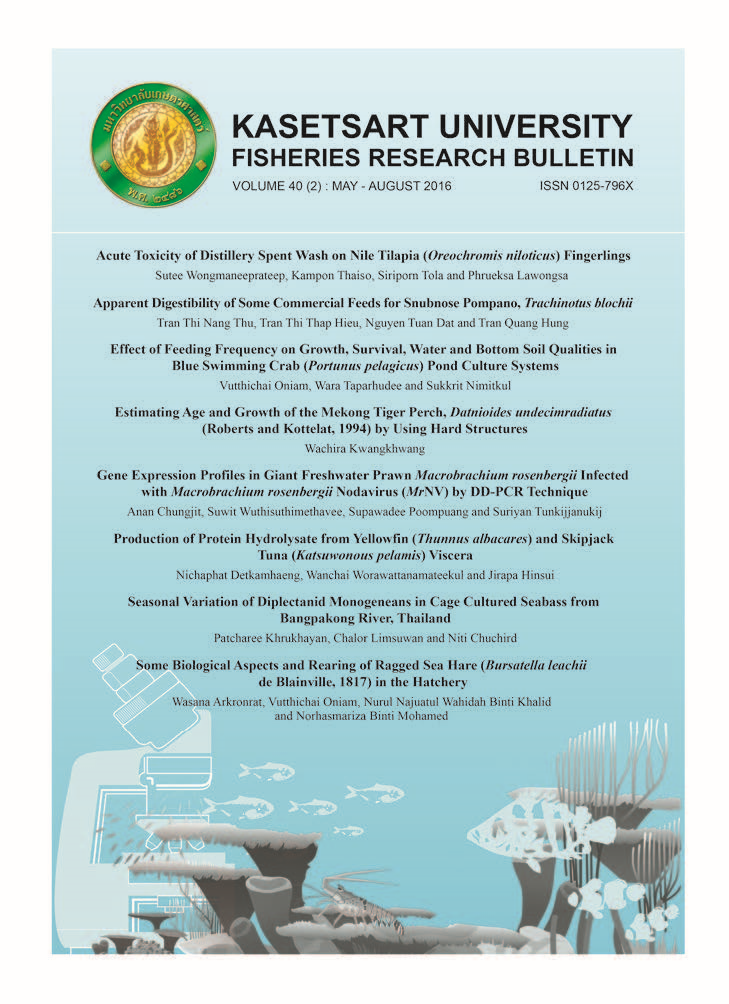Apparent Digestibility of Some Commercial Feeds for Snubnose Pompano, Trachinotus blochii
Main Article Content
Abstract
The study was conducted at the National Broodstock Center for Mariculture Species in Northern Vietnam (Center), Cat Ba, Hai Phong province, to evaluate the digestibility of protein (ADP), lipid (ADL) and energy (ADE) of some available commercial feeds for snubnose pompano, Trachinotus blochii, using indirect method with chromic oxidize (Cr203) 1% as inert marker. Experimental fish of 400 g/individual size were held in marine cags (cage size, 3 x 3 x 3 m) at a density of 10 fish/m3. The digestibility of three commercial aquafeed brands (protein contents of 46, 50 and 51% abbreviated as D46, D50 and D51, respectively, with three replicates). Fish were fed by hand to apparent satiety in the morning at 0900 hrs for 2 weeks to acclimate with experimental conditions. The faeces were then collected by manual stripping method for four weeks. Faeces after sampling were pooled in sealed bottles and stored at -20°C until analysed. The results showed that ADP significantly differed among feeds (P<0.05), with the highest value recorded for D51 (82.25%), followed by D50 at 75.17%, and D46 at 68.76%. ADE ofD51 feed (82.32%) was statistically higher than that ofD46 (66.63%) and D50 (68.20%) (P<0.05), while that of two latter feeds did not differ (P>0.05). The ADL values were relatively high and had no significant variation between D46 and D51 (P>0.05).
Article Details
References
2. Austreng, E. (1978). Digestibility determination in fish using chromic oxide marking and analysis of contents from different segments of the gastrointestinal tract. Aquaculture 13: 265-272.
3. Cho, C. B. Cowey and T. Watanabe. (1995). Finfish nutrition in Asia: International Development Research Centre, Ottawa, Canada.
4. Czarnocki, J., I.R. Sibbald and E.V. Evans. (1961). The determination of chromic oxide insamples of feed and excreta by acid digestion and spectrophotometry. Canadian Journal of Animal Science 41(2): 167-179.
5. Fenton, T.W. and M. Fenton. (1979). An improved procedure for the determination of chromic oxide in feed and feces. Canadian Journal of Animal Science 59(3):631-634.
6. Glencross, B.D., M. Booth and G.L. Allan. (2007). A feed is only as good as its ingredients - a review of ingredient evaluation strategies for aquaculture feeds. Aquaculture Nutrition 13(1): 17-34.
7. Hung, L.V., H.T. Thu, T.V. Dung, T.T.L. Trang and P.T. Khanh. (2014). Effect of vitamin d3 levels on growth and survival rate of snubnose pompano juvenile (Trachinotus blochii Lacepéde, 1801). Journal of Marine Science and Technology 13(4):390-396.
8. Hung, L.V., HT. Thu and T.T.L. Trang. (2013). Effect of protein levels on growth performance and survival rate of juvenile Pompano (Trachinotus blochii, Lacepede, 1801) (In Vietnamese). Journal of Agricultural Sciences, Biology and Medicine (Hue University) 79(1) (2013).
9. Lazo, J.P., D.A. Davis and C.R. Arnold. (1998). The effects of dietary protein level on growth, feed efficiency and survival of juvenile Florida pompano (Trachinotus carolinus). Aquaculture 169(3-4):225-232.
10. Ma, Z., H. Guo, P. Zheng, L. Wang, S. Jiang, D. Zhang and J.G. Qin. (2014). Effect of salinity on the rearing performance of juvenile golden pompano Trachinotus ovatus (Linnaeus 1758). Aquaculture Research DOI: 10.1111/are.12633.
11. Manh, N.V., L.V. Hung and T.V. Dung. (2013). Effect of stocking density on growth performance and survival rate of juvenile pompano (in Vietnamese). Vietnam Journal of Science and Technology 15:55-59.
12. NRC. (1993). Nutrient Requirements of Fish. National Research Council. National Academy Press,Washington, DC.
13. Peres, H. and A. Oliva-Teles. (1999). Effect of dietary lipid level on growth performance and feed utilization by European sea bass juveniles (Dicentrarchus labrax). Aquaculture 179(1--4):325-334.
14. Riche, M. (2009). Evaluation of Digestible Energy and Protein for Growth and Nitrogen Retention inJuvenile Florida Pompano, Trachinotus carolinus. Journal of the World Aquaculture Society 40(1):45-57.
15. Sa, R, P. PousÃO-Ferreira and A Oliva-Teles. (2006). Effect of dietary protein and lipid levels on growth and feed utilization of white sea bream (Diplodus sargus) juveniles. Aquaculture Nutrition 12(4):310-321.
16. Santinha, P.J.M., F. Medale, G. Corraze and E.F.S. Gomes (1999). Effects of the dietary protein : lipid ratio on growth and nutrient utilization in gilthead seabream (Sparus aurata L.). Aquaculture Nutrition 5(3):147-156.
17. Wilson, R.P. (2002). Amino acid and protein (chapter 3). In: Halver, J.E., Hardy, R.W., Fish Nutrition (3rd Edition). Academic Press: Elsevier Science Imprint. San Diego, USA, pp. 143- 179.
18. Xan, L. (2007). Study on biology, growout and broodstock farming technique of five potential marine fish species: Brown-marbled grouper (Epinephelus fuscoguttatus ), Giant grouper (Epinephelus lanceolatus), Humpback grouper (Cromileptes altivelis), Mangrove red snapper ( Lutjanus argentimaculatus ), Pompano (Trachinotus blochii) (in Vietnamese). Project Report (2004- 2006). Ministry of Agriculture and Rural Development.
19. Yu, H.R., Q. Zhang, H. Cao, X.Z. Wang, G.Q. Huang, B.R. Zhang, J.J. Fan, S.W. Liu, W.Z. Li and Y. Cui. (2013). Apparent digestibility coefficients of selected feed ingredients for juvenile snakehead, Ophiocephalus argus. Aquaculture Nutrition 19(2):139- 147.

